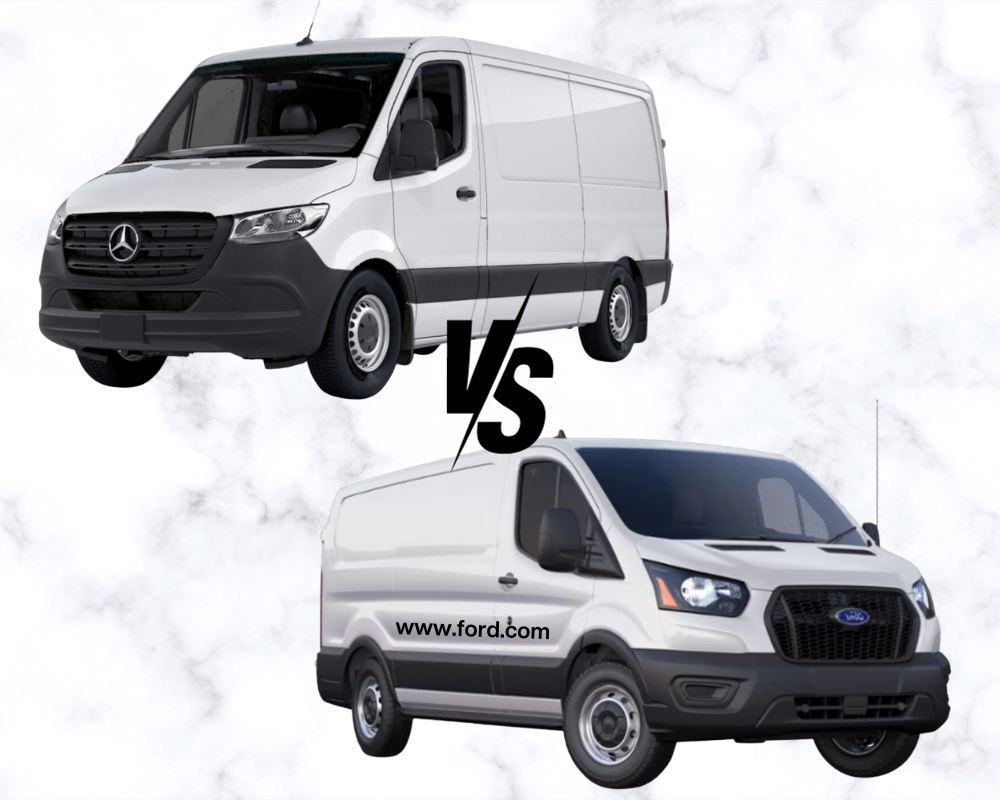The Mercedes-Benz Sprinter and Ford Transit are top contenders in the commercial van market. Each offers distinct features suitable for various business needs.
Choosing between the Mercedes-Benz Sprinter and Ford Transit for your business can be challenging. Both vehicles have carved niches in the commercial van sector, known for their reliability, spacious interiors, and customization options. The Sprinter is often praised for its advanced safety features and premium feel, while the Transit is acclaimed for its powerful engine options and overall value.
Business owners and fleet managers prioritize these models for their cargo capacity and versatility. The decision between the two ultimately depends on specific requirements such as budget, preferred driving dynamics, and brand loyalty. Selecting the right van is crucial for operational efficiency and long-term satisfaction in your commercial endeavors.

Credit: m.youtube.com
Mercedes Sprinter And Ford Transit: Van Titans
Both the Mercedes Sprinter and the Ford Transit dominate the van market. Their presence is strong among businesses and individuals alike. The Sprinter is often seen as a luxury option, known for its build quality and comfort. On the other hand, the Transit is praised for its versatility and cost-effectiveness, making it a popular choice for a wide range of users.
The Sprinter and Transit serve many industries. Delivery services and tradespeople value their reliability. They are also favorites for camper van conversions. Large fleets often feature these models due to their durability and efficient design. Both vans have carved out significant roles in urban and rural settings, proving their worth on the road.
Under The Hood: Performance Metrics
The Sprinter and Transit vans offer unique engine options. Sprinter’s line-up includes a powerful 3.0L V6 turbo diesel engine. This engine delivers impressive torque for heavy loads. On the other hand, the Transit boasts a versatile range with its 3.5L EcoBoost V6 gas engine. This option provides a strong balance of power and efficiency.
Fuel efficiency is a key factor for many drivers. The Sprinter’s diesel engine excels in long-haul fuel economy. The Transit’s EcoBoost engine focuses on efficient city driving. Specific numbers vary based on the model and driving conditions.
| Vehicle | Engine Type | Fuel Economy (MPG) |
|---|---|---|
| Sprinter | 3.0L V6 Turbo Diesel | Varies |
| Transit | 3.5L EcoBoost V6 | Varies |
Design Philosophies: Style And Functionality
The Sprinter and Transit showcase distinct design philosophies. Exterior aesthetics differ greatly. The Sprinter’s lines are sleek, implying speed and efficiency. Its streamlined shape stands out. Conversely, the Transit opts for a more utilitarian look, focusing on practicality with a boxier frame.
Regarding interior ergonomics and comfort, both prioritize driver and passenger experience. The Sprinter provides a high-end feel, with a focus on driving dynamics and seat comfort. The Transit, meanwhile, emphasizes spaciousness and versatility, catering to a range of needs from cargo to passenger transport.
Payload Capacities: Carrying Your Load
The Ford Transit and Mercedes Sprinter have different cargo capacities. The Transit offers up to 487.3 cubic feet of space. The Sprinter, on the other hand, provides a bit less with up to 319 cubic feet.
For maximum payload, the Sprinter can handle up to 5,000 pounds. The Transit can carry slightly more, with a capacity of up to 5,110 pounds. Both vans support considerable towing abilities, suitable for varied transportation needs.
Tech Features: Connectivity And Navigation
Sprinter and Transit vans boast impressive tech features. Users enjoy cutting-edge infotainment systems in both vehicles. These systems provide navigation services and connectivity options for a seamless ride. The Sprinter’s MBUX system stands out with its voice control capabilities.
The Transit follows closely with Ford’s SYNC 3 interface. Both models ensure drivers stay connected on the go. Safety is a top priority, with each van offering advanced driver-assist technologies. This includes lane-keeping assistance and collision prevention. These features help drivers avoid accidents and drive with confidence.

Credit: flatlinevanco.com
Customization And Variants
The Sprinter and Transit offer different wheelbase and roof height options. The Sprinter’s wheelbase sizes range, catering to varied cargo needs. Its roof heights also vary, enabling standing room in the cargo area. The Transit similarly provides multiple wheelbase lengths. It includes three roof heights, accommodating different storage capacities.
Looking at specialized models, the Sprinter shines with a 4×4 version. This model suits off-road and rough terrain travel. The Transit lacks a factory 4×4 option but excels with its EcoBoost engines, delivering power and efficiency. Both models have aftermarket modifications available. Enthusiasts can customize these vans to meet specific needs, from luxury mobile offices to camper conversions.
Reliability And Maintenance: Keeping The Wheels Turning
Reliability and maintenance are crucial for any vehicle, particularly for those like the Sprinter and Transit vans. Vehicle owners often weigh the benefits of warranty and service intervals when making a purchase decision.
| Sprinter | Transit |
|---|---|
| Basic Warranty: 3 years/36,000 miles | Basic Warranty: 3 years/36,000 miles |
| Service Interval: Every 20,000 miles | Service Interval: Every 10,000 miles |
Long-term durability is a key factor to consider. The Sprinter is known for a sturdy build but might require costly repairs post-warranty. Transit vans offer affordable maintenance but may face more frequent service needs. Careful consideration of these factors ensures smooth operation over the years.
Cost Of Ownership: Initial And Long-term Expenses
Comparing the Sprinter and Transit vans reveals key cost differences. The Sprinter’s purchase price is typically higher than the Transit’s. This affects initial investment. Yet, the Sprinter often boasts a stronger resale value. This can soften the blow of the upfront costs over time.
Depreciation for both vehicles varies with usage and maintenance. Generally, the Transit may depreciate faster. This could lead to a lower resale value. Potential owners must consider this alongside insurance, fuel efficiency, and maintenance expenses. These factors contribute to the total cost of ownership.
User Experiences And Testimonials
Customer satisfaction ratings often highlight key differences between Sprinter and Transit vans. Many users rate the Sprinter highly for its reliability and comfort. On the other hand, the Transit scores well on affordability and maintenance costs. Both models receive good marks for their versatility and cargo space.
Real-world use cases show the Sprinter excels in long-distance travel and heavy-duty applications. It is favored by businesses for its durable engine and smooth handling. The Transit, conversely, is preferred for urban and light commercial use. It stands out in ease of maneuverability and fuel efficiency, making it ideal for city logistics.
The Verdict: Choosing The Right Van For You
Choosing between a Sprinter and a Transit van is crucial for your needs. The Sprinter shines with its superior build quality and impressive fuel efficiency. It’s known for a comfortable ride and high resale value. On the other hand, the Transit boasts a lower initial cost and versatile body styles. It offers ample cargo space and is easier to customize.
Key factors to consider include budget, purpose of use, and driving conditions. Consider the total cost of ownership, which includes maintenance, fuel, and insurance. Think about the van’s payload and towing capacity. Your choice should align with your specific needs and business requirements.

Credit: www.mercedesoflittleton.com
Which Van Conversion Kit Is Best Suited for a Sprinter or Transit?
When considering van conversion kits for a Sprinter or Transit, it’s important to find the right fit. Many van owners have found success with Promaster van conversion kits, which offer customization and functionality for a variety of needs. These kits can help create a comfortable and versatile space within your van.
Frequently Asked Questions
Is Transit Better Than Sprinter?
The choice between a Transit and Sprinter depends on your needs. Ford Transits offer more configurations and lower upfront costs, while Mercedes Sprinters provide superior build quality and better fuel efficiency. Each has its advantages for different business requirements.
Why Are Sprinter Vans So Expensive?
Sprinter vans are expensive due to their durable build, advanced technology, and versatile design that supports customization for various commercial uses. They also offer superior performance and longevity, justifying their higher price point.
Why Are Sprinter Vans So Popular?
Sprinter vans are popular for their spacious interiors, fuel efficiency, and versatility. They cater to various needs, from cargo transport to luxury mobile offices. Their durability and brand reputation also contribute to their widespread appeal.
Can A Sprinter Van Be A Daily Driver?
Yes, a Sprinter van can be a daily driver. Its spacious interior and fuel efficiency make it suitable for everyday use. The vehicle also offers comfort and reliable performance, ideal for both city and highway driving.
Conclusion
Deciding between a Sprinter and a Transit hinges on your specific needs. Each van offers distinct advantages to suit diverse requirements. Consider cargo space, fuel efficiency, and driving comfort. Your choice should align with your business demands or personal preferences.
Ultimately, the right van will boost your efficiency and satisfaction.
{ “@context”: “https://schema.org”, “@type”: “FAQPage”, “mainEntity”: [ { “@type”: “Question”, “name”: “Is Transit better than Sprinter?”, “acceptedAnswer”: { “@type”: “Answer”, “text”: “The choice between a Transit and Sprinter depends on your needs. Ford Transits offer more configurations and lower upfront costs, while Mercedes Sprinters provide superior build quality and better fuel efficiency. Each has its advantages for different business requirements.” } } , { “@type”: “Question”, “name”: “Why are Sprinter vans so expensive?”, “acceptedAnswer”: { “@type”: “Answer”, “text”: “Sprinter vans are expensive due to their durable build, advanced technology, and versatile design that supports customization for various commercial uses. They also offer superior performance and longevity, justifying their higher price point.” } } , { “@type”: “Question”, “name”: “Why are Sprinter vans so popular?”, “acceptedAnswer”: { “@type”: “Answer”, “text”: “Sprinter vans are popular for their spacious interiors, fuel efficiency, and versatility. They cater to various needs, from cargo transport to luxury mobile offices. Their durability and brand reputation also contribute to their widespread appeal.” } } , { “@type”: “Question”, “name”: “Can a Sprinter van be a daily driver?”, “acceptedAnswer”: { “@type”: “Answer”, “text”: “Yes, a Sprinter van can be a daily driver. Its spacious interior and fuel efficiency make it suitable for everyday use. The vehicle also offers comfort and reliable performance, ideal for both city and highway driving.” } } ] }